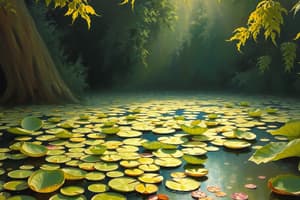Podcast
Questions and Answers
What is the main process through which autotrophs and heterotrophs get their energy?
What is the main process through which autotrophs and heterotrophs get their energy?
- Chemosynthesis
- Cellular respiration (correct)
- Photosynthesis
- Decomposition
Which type of consumers eat primary consumers in a food chain?
Which type of consumers eat primary consumers in a food chain?
- Autotrophs
- Decomposers
- Tertiary consumers (correct)
- Secondary consumers
What is the main source of energy for autotrophs that use photosynthesis?
What is the main source of energy for autotrophs that use photosynthesis?
- Carbon dioxide
- Hydrogen sulfide
- Glucose
- Sunlight (correct)
Where are chemoautotrophs commonly found due to the lack of sunlight?
Where are chemoautotrophs commonly found due to the lack of sunlight?
Which organism group can exhibit heterotrophic, photosynthetic, and chemosynthetic characteristics?
Which organism group can exhibit heterotrophic, photosynthetic, and chemosynthetic characteristics?
What is the main difference between autotrophs and heterotrophs?
What is the main difference between autotrophs and heterotrophs?
Why are autotrophs called producers?
Why are autotrophs called producers?
What do herbivores primarily eat?
What do herbivores primarily eat?
Why are decomposers important in an ecosystem?
Why are decomposers important in an ecosystem?
Which organisms are classified as heterotrophs?
Which organisms are classified as heterotrophs?
Flashcards are hidden until you start studying
Study Notes
Autotrophs and Heterotrophs
- Autotrophs and heterotrophs get their energy through cellular respiration, where cells use glucose or other food molecules to make ATP.
- Autotrophs make their own food, while heterotrophs must eat to get food.
Energy Flow in Ecosystems
- Food energy flows from autotrophs to heterotrophs through the food chain.
- The base of the food chain is made up of autotrophs, which produce food for the rest of the food chain and the entire food web.
- A food web is a diagram made of multiple food chains.
Types of Heterotrophs
- Primary consumers, such as deer or rabbits, eat autotrophs.
- Secondary consumers, such as foxes or snakes, eat primary consumers.
- Tertiary consumers, such as hawks, eat secondary consumers.
- Decomposers, such as fungi and bacteria, eat dead or decaying matter and recycle nutrients back into the ecosystem.
Energy Sources for Autotrophs
- Autotrophs use two main sources of energy to make food: sunlight and inorganic molecules.
- Phototrophs, such as green plants, algae, and some bacteria, use sunlight to make food through photosynthesis.
- Chemoautotrophs, such as some bacteria, use the energy stored in inorganic molecules to make food through chemosynthesis.
Chemoautotrophs
- Chemoautotrophs are especially common in deep sea vent ecosystems, where there is a lack of sunlight.
- Bacteria in deep sea vents use chemosynthesis to provide food and energy for the rest of the ecosystem.
Examples of Autotrophs and Heterotrophs
- Examples of autotrophs include corn, algae, trees, grass, cyanobacteria, and chemosynthetic bacteria.
- Examples of heterotrophs include beetles, fungi, lizards, hawks, and decomposers.
Decomposers
- Decomposers are heterotrophs that eat dead or decaying matter and recycle nutrients back into the ecosystem.
- Examples of decomposers include some bacteria, worms, and fungi.
Studying That Suits You
Use AI to generate personalized quizzes and flashcards to suit your learning preferences.




